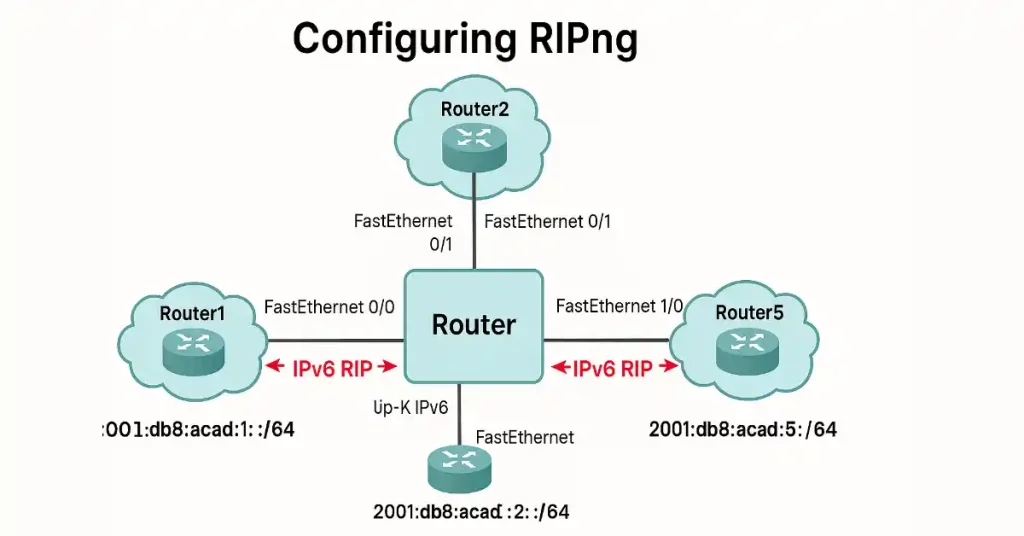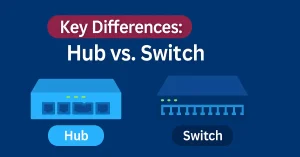IPv6 Routing Information Protocol (RIP), also known as RIPng (RIP Next Generation), supports IPv6 addresses. It is a Distance Vector routing protocol that uses a hop count as a routing metric. After enabling IPv6 RIP, we also need to configure the advertisement of IPv6 RIP routes. We can display IPv6 RIP settings to verify the configuration of RIPng.
It is helpful as a foundation for understanding basic network routing. Now, examine the reference topology in the figure. In this topology, all routers’ basic configurations have been completed, and all router interfaces have been configured and enabled. However, there are no dynamic routing and static routes configured on the routers, so remote network access is currently not possible.
RIPng is the IPv6 version of RIP, adapted for IPv6 addressing. Key differences from RIPv2:
- Uses UDP port 521 and multicast FF02::9.
- No network command; enabled per interface.
- Supports authentication via IPsec (CCNP level).
Advantages: Simple to configure for small networks. Limitations: 15-hop max, slow convergence.
IPv6 RIP vs RIPv2
| Feature | RIPng | RIPv2 |
|---|---|---|
| Address Family | IPv6 | IPv4 |
| Multicast | FF02::9 | 224.0.0.9 |
| Config Mode | Interface | Network cmd |
Before enabling RIPng on interfaces, you must create a process in global configuration mode using the IPv6 router rip <process-name>. This is different from RIPv2, where you use router rip and network commands. The process name is local to the router.

Configuration
So, let’s come to the above topology configuration. As I said earlier, all basic configuration and IP address configuration on router interfaces have been done, so we now only require the configuration of RIP next-generation on all interfaces:
Router0
Router0>configure terminal
Router0(config)#ipv6 unicast-routing
Router0(config)#interface FastEthernet 0/0
Router0(config-if)#ipv6 rip fschubR1Rng enable
Router0(config-if)#exit
Router0(config)#interface FastEthernet 0/1
Router0(config-if)#ipv6 rip fschubR1Rng enable
Router0(config-if)#exit
Router0(config)#exit
Router0>
Router1
Router1#configure terminal
Router1(config)#ipv6 unicast-routing
Router1(config)#interface fastEthernet 0/0
Router1(config-if)#ipv6 rip fschubRIPng enable
Router1(config-if)#exit
Router1(config)#interface fastEthernet 0/1
Router1(config-if)#ipv6 rip fschubRIPng enable
Router1(config-if)#exit
Router1(config)#interface fastEthernet 1/0
Router1(config-if)#ipv6 rip fschubRIPng enable
Router1(config-if)#exit
Router1(config)#exit
Router1#
Enable IPv6 unicast-routing on Router2, Router3, Router4, and Router5, and configure all RIPng interfaces using the command ipv6 rip RIPNG_PROCESS enable after creating the global process with ipv6 router rip RIPNG_PROCESS.
Propagate Default IPv6 Route
The default IPv6 static route propagating process in RIPng is equal to RIPv2, except that an IPv6 default static route must be specific. The command for propagating a default static IPv6 route is the following:
Router0(config)ipv6 route 0::/0
Router0(config)ipv6 rip default-information originate
The IPv6 route is the global configuration mode command, and the IPv6 rip is the interface mode command.
Propagate Default IPv6 Route
Propagating a Default IPv6 Route in RIPng
To propagate a default route (::/0), first configure a static default route, then enable origination in the RIPng process. This is similar to RIPv2 but uses IPv6 syntax.
Example on Router0 (assuming it’s the edge router):
Router0(config)#ipv6 route ::/0 <next-hop-ipv6-address> # e.g., ::/0 2001:DB8::1 or via interface Router0(config)#ipv6 router rip RIPNG_PROCESS Router0(config-router)#default-information originate</next-hop-ipv6-address>
The originate keyword advertises the default route with other routes. Use only to advertise only the default. This is a global router mode command, not interface.
Verifying the IPv6 Routing Information Protocol (RIP) Configuration
We can verify and examine the configuration using the show ipv6 protocol command, but the amount of information, as it is for its IPv4 counterpart, is not the same. However, we can confirm the following parameters using the command:
IRIPing is configured on the router and is also running.
The interfaces where RIPng is enabled.
We can also use the show ipv6 route command to display the routing table information, as shown in the Figure. The output can confirm the IPv6 routes installed in the routing table.
![Cisco router command line interface showing IPv6 routing table with a RIPng route highlighted, including the entry '2001:AD10:110B::/64 [120/2]' via FastEthernet0/0, used for CCNA and CCNP IPv6 routing configuration tutorial.](https://networkustad.com/wp-content/uploads/2019/08/RIPng-Verification-1.webp)
Examine the routing table to see the hop count from Router0 to Router2. Notice that Router0 has two hops for the Router2 network if we configure RIPv1 or RIPv2 for the same Router2. The hop count will be one. This is because the IPv4 routing count of the next-hop router is the first hop, but the RIPng count of the sending router is the first hop.
Metrics and Hop Count
It uses hop count as its metric (max 15, like RIPv2). When a router advertises a route, it increments the metric by 1. For example, in a topology R0-R1-R2:
- R2 advertises its local network to R1 with metric 1.
- R1 installs it with metric 1, advertises to R0 with metric 2.
- R0 installs with metric 2 (two hops away).
This is identical to RIPv2.
Sample Verification Outputs
Use show ipv6 protocols to confirm:
Router0#show ipv6 protocols IPv6 Routing Protocol is “rip RIPNG_PROCESS” Interfaces: FastEthernet0/0 FastEthernet0/1 Redistribution: None
Use show ipv6 route rip to see routes:
R 2001:DB8:2::/64 [120/2] # Metric 2 example via FE80::2, FastEthernet0/0
Add troubleshooting: If routes are missing, check IPv6 unicast-routing, interface enables, and link-local addresses.
Conclusion
Students with foundational skills in IPv6 dynamic routing, bridging simple configurations to advanced troubleshooting. By understanding its setup, metrics, and limitations compared to protocols like OSPFv3, you’ll be prepared for real-world networks. Practice these commands in labs to solidify your expertise and stay ahead in evolving Cisco environments.
FAQs
What are the key differences between RIPng and RIPv2?
RIPng supports IPv6 with interface-based enabling, uses UDP port 521 and multicast FF02::9, and offers IPsec authentication for security. RIPv2 is IPv4-focused with network commands. Both use hop count metrics up to 15, but RIPng adapts to IPv6 addressing for modern networks.
How do I enable IPv6 RIP on a Cisco router interface?
First, enable IPv6 unicast-routing globally, create the process with ipv6 router rip RIPNG_PROCESS, then on each interface use ipv6 rip RIPNG_PROCESS enable. This differs from RIPv2’s global mode, ensuring per-interface control for precise IPv6 routing.
What commands verify RIPng configuration?
Use show ipv6 protocols to check the process and interfaces, and show ipv6 route rip for routing table entries with metrics. For example, routes show as R with [120/2] for a two-hop path. Debug ipv6 rip helps troubleshoot updates.
How can I propagate a default IPv6 route?
Configure a static default with ipv6 route ::/0 , then under ipv6 router rip RIPNG_PROCESS, add default-information originate to advertise it. Use ‘only’ to send just the default, similar to RIPv2 but with IPv6 syntax for edge routers.





